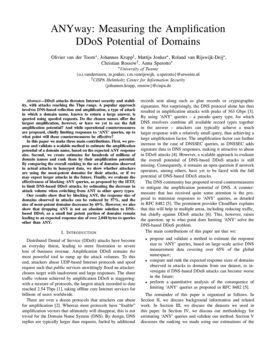DDoS attacks threaten Internet security and stability, with attacks reaching the Tbps range. A popular approach involves DNS-based reflection and amplification, a type of attack in which a domain name, known to return a large answer, is queried using spoofed requests. Do the chosen names offer the largest amplification, however, or have we yet to see the full amplification potential? And while operational countermeasures are proposed, chiefly limiting responses to ‘ANY’ queries, up to what point will these countermeasures be effective? In this paper we make three main contributions. First, we propose and validate a scalable method to estimate the amplification potential of a domain name, based on the expected ANY response size. Second, we create estimates for hundreds of millions of domain names and rank them by their amplification potential. By comparing the overall ranking to the set of domains observed in actual attacks in honeypot data, we show whether attackers are using the most-potent domains for their attacks, or if we may expect larger attacks in the future. Finally, we evaluate the effectiveness of blocking ANY queries, as proposed by the IETF, to limit DNS-based DDoS attacks, by estimating the decrease in attack volume when switching from ANY to other query types. Our results show that by blocking ANY, the response size of domains observed in attacks can be reduced by 57%, and the size of most-potent domains decreases by 69%. However, we also show that dropping ANY is not an absolute solution to DNS-based DDoS, as a small but potent portion of domains remain leading to an expected response size of over 2,048 bytes to queries other than ANY.
Posts for: #DDoS
Bachelor Thesis
My Bachelor assignment was the perfect way of deciding at which chair I wanted to follow the Electrical Engineering Master. I was interested in both the Design and Analysis of Communication Systems (DACS) chair and the Telecommunication Engineering (TE) chair. Ultimately I decided to do my Bachelor assignment at the DACS chair. So I met with all the AIO’s working at DACS to see what kind of assignments they could offer me. All of the assignments were on state of the art topics. Cloud-networks for mobile providers, dimensioning link-capcity, etc. I chose to work with Rick Hofstede, his assignment was about HTTP(S) intrusion detection. His previous research was in the field of SSH intrusion detection, and he wanted to see if the same could be done with HTTP(S).
